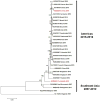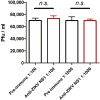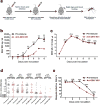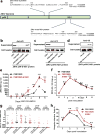Evolutionary enhancement of Zika virus infectivity in Aedes aegypti mosquitoes
- PMID: 28514450
- PMCID: PMC5885636
- DOI: 10.1038/nature22365
Evolutionary enhancement of Zika virus infectivity in Aedes aegypti mosquitoes
Abstract
Zika virus (ZIKV) remained obscure until the recent explosive outbreaks in French Polynesia (2013-2014) and South America (2015-2016). Phylogenetic studies have shown that ZIKV has evolved into African and Asian lineages. The Asian lineage of ZIKV was responsible for the recent epidemics in the Americas. However, the underlying mechanisms through which ZIKV rapidly and explosively spread from Asia to the Americas are unclear. Non-structural protein 1 (NS1) facilitates flavivirus acquisition by mosquitoes from an infected mammalian host and subsequently enhances viral prevalence in mosquitoes. Here we show that NS1 antigenaemia determines ZIKV infectivity in its mosquito vector Aedes aegypti, which acquires ZIKV via a blood meal. Clinical isolates from the most recent outbreak in the Americas were much more infectious in mosquitoes than the FSS13025 strain, which was isolated in Cambodia in 2010. Further analyses showed that these epidemic strains have higher NS1 antigenaemia than the FSS13025 strain because of an alanine-to-valine amino acid substitution at residue 188 in NS1. ZIKV infectivity was enhanced by this amino acid substitution in the ZIKV FSS13025 strain in mosquitoes that acquired ZIKV from a viraemic C57BL/6 mouse deficient in type I and II interferon (IFN) receptors (AG6 mouse). Our results reveal that ZIKV evolved to acquire a spontaneous mutation in its NS1 protein, resulting in increased NS1 antigenaemia. Enhancement of NS1 antigenaemia in infected hosts promotes ZIKV infectivity and prevalence in mosquitoes, which could have facilitated transmission during recent ZIKV epidemics.
Conflict of interest statement
The authors declare that they have no competing financial interests.
Figures













Comment in
-
Viral evolution: Zika is on point to increase spread.Nat Rev Microbiol. 2017 Jul;15(7):381. doi: 10.1038/nrmicro.2017.62. Epub 2017 May 30. Nat Rev Microbiol. 2017. PMID: 28555074 No abstract available.
-
A Single Substitution Changes Zika Virus Infectivity in Mosquitoes.Trends Microbiol. 2017 Aug;25(8):603-605. doi: 10.1016/j.tim.2017.05.014. Epub 2017 Jun 10. Trends Microbiol. 2017. PMID: 28610876
References
-
- Marchette NJ, Garcia R, Rudnick A. Isolation of Zika virus from Aedes aegypti mosquitoes in Malaysia. Am J Trop Med Hyg. 1969;18:411–415. - PubMed
-
- Oehler E, et al. Zika virus infection complicated by Guillain-Barre syndrome-case report, French Polynesia, December 2013. Eurosurveillance. 2014;19:4–6. - PubMed
-
- Cordeiro MT, Pena LJ, Brito CA, Gil LH, Marques ET. Positive IgM for Zika virus in the cerebrospinal fluid of 30 neonates with microcephaly in Brazil. Lancet. 2016;387:1811–1812. - PubMed
Publication types
MeSH terms
Substances
Grants and funding
LinkOut - more resources
Full Text Sources
Other Literature Sources
Medical
Research Materials

